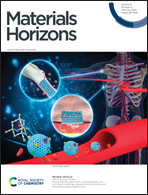Exploring the anion chemical space of Ln2OF2−xClxH2 (Ln = Y, La, Gd): a model of electroelastic material with high mechanical sensitivity and energy harvesting†
Abstract
The main result of our investigation is the prediction of a new family of multianion compounds – Ln2OF2−xClxH2 (Ln = Y, La, Gd) which due to anomalous elastic behaviour could present interest for the design and development of electromechanical devices. The composition Ln2OF2−xClxH2 utilizes a complex heteroatomic anion [OF2−xClxH2]6−; in a solid state, as it follows from the DFT calculations, the system crystallizes into a columnar-type layered structure of P3m1 or R3m trigonal symmetries in which the LnO(F,Cl)H and Ln(F,Cl)FH layers are uniformly stacked in an alternating order along the high-symmetry c axis. In the trigonal lattice without an inversion center, the resulting two-layer geometry puts groups of the anionic species together in a way that gives rise to a strong localization of valence charge density. We showed that being globally stable, such specific crystal architecture may lead to a high asymmetry of mechanical and electrical responses with respect to imposed loads. Moreover, small dynamic changes of the equilibrium charge and bonding configurations may cause rather enhanced structural sensitivity of the elastic responses at low pressures. Comparison of electromechanical characteristics showed that the predicted materials can serve as direct successors of the line of polyvinylidene fluoride (PVDF) piezopolymers.

- This article is part of the themed collection: Materials Horizons 10th anniversary regional spotlight collection: Europe


 Please wait while we load your content...
Please wait while we load your content...